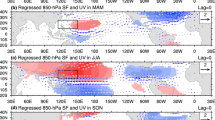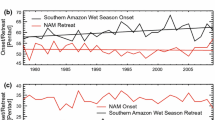Abstract
The South Asian high (SAH) is a huge anticyclone in the upper troposphere. It influences the climate and the distribution of trace constituents and pollutants. The present study documents the change in the SAH and precipitation under global warming, as well as the possible link between the changes, based on 17 Coupled Model Intercomparison Project Phase 5 (CMIP5) model simulations. The CMIP5 historical simulation reproduces reasonably the tropospheric circulation (including the SAH), precipitation, and moisture. Under global warming, more than 75 % of the CMIP5 models project a southward shift of the SAH. The southward shift is more significant in the models with stronger anticyclonic circulation in the south part of the climatological SAH. The precipitation response displays a contrasting feature: negative over the southeastern equatorial Indian Ocean (IO) and positive over the tropical northern IO, the Bay of Bengal, and the equatorial western Pacific. The results of a linear baroclinic model (LBM) show that the regional rainfall changes over the Bay of Bengal and the equatorial western Pacific have a main contribution to the southward shift of the SAH. In addition, the precipitation and the surface wind responses over the Indo-Pacific region are well coupled. On one hand, the surface wind anomaly affects the rainfall response through altering the SST and moisture. On the other hand, the condensational heating released by regional rainfall changes sustains the surface wind response.










Similar content being viewed by others
References
Boos WR, Kuang Z (2010) Dominant control of the South Asian monsoon by orographic insulation versus plateau heating. Nature 463(7278):218–222
Chiang JCH, Sobel AH (2002) Tropical tropospheric temperature variations caused by ENSO and their influence on the remote tropical climate. J Clim 15:2616–2631
Dethof A, O’Neill A, Slingo JM, Smit HGJ (1999) A mechanism for moistening the lower stratosphere involving the Asian summer monsoon. Q J R Meteorol Soc 125(556):1079–1106
Duan AM, Wu GX (2005) Role of the Tibetan Plateau thermal forcing in the summer climate patterns over subtropical Asia. Clim Dyn 24(7–8):793–807
Duan A, Hu J, Xiao Z (2013) The Tibetan Plateau summer monsoon in the CMIP5 simulations. J Climate 26:7747–7766. doi: http://dx.doi.org/10.1175/JCLI-D-1112-00685.00681
Flohn H (1960) Recent investigations on the mechanism of the “Summer Monsoon” of Southern and Eastern Asia. Symposium on monsoons of the world, New Delhi. Hind Union Press, In, pp 75–88
Held IM, Soden BJ (2006) Robust responses of the hydrological cycle to global warming. J Climate 19(21):5686–5699
Hoskins BJ, Rodwell MJ (1995) A model of the Asian summer monsoon. Part I: the global scale. J Atmos Sci 52(9):1329–1340
Hsu P, Li T (2012) Is “rich-get-richer” valid for Indian Ocean and Atlantic ITCZ? Geophys Res Lett 39(13), L13705
Huang R, Sun F (1992) Impact of the tropical western Pacific on the East Asian summer monsoon. J Meteorol Soc Jpn 70(1):243–256
Huang R, Wu Y (1989) The influence of ENSO on the summer climate change in China and its mechanism. Adv Atmos Sci 6:21–32
Huang R, Huang G, Ren B (1999) Advances and problems needed for further investigation in the studies of the East Asian summer monsoon. Chin J Atmos Sci 23(2):129–141
Jiang XW, Li YQ, Yang S, Wu R (2011) Interannual and interdecadal variations of the South Asian and western Pacific subtropical highs and their relationship with the Asian-Pacific summer climate. Meteorog Atmos Phys 113:171–180
Kalnay E, Kanamitsu M, Kistler R, Collins W, Deaven D, Gandin L, Iredell M, Saha S, White G, Woollen J (1996) The NCEP/NCAR 40-year reanalysis project. Bull Amer Meteor Soc 77(3):437–471
Li Q, Jiang JH, Wu DL, Read WG, Livesey NJ, Waters JW, Zhang Y, Wang B, Filipiak MJ, Davis CP (2005) Convective outflow of South Asian pollution: a global CTM simulation compared with EOS MLS observations. Geophys Res Lett 32:L14826. doi:10.1029/2005GL022762
Liu Y, Wu G, Liu H, Liu P (2001) Condensation heating of the Asian summer monsoon and the subtropical anticyclone in the Eastern Hemisphere. Clim Dyn 17(4):327–338
Mason RB, Anderson CE (1963) The development and decay of the 100-MB summertime anticyclone over Southern Asia. Mon Weather Rev 91(1):3–12
Meehl GA, Goddard L, Murphy J, Stouffer RJ, Boer G, Danabasoglu G, Dixon K, Giorgetta MA, Greene AM, Hawkins E (2009) Decadal prediction. Bull Am Meteorol Soc 90(10):1467–1485
Park M, Randel WJ, Kinnison DE, Garcia RR, Choi W (2004) Seasonal variation of methane, water vapor, and nitrogen oxides near the tropopause: satellite observations and model simulations. J Geophys Res 109:D03302. doi:10.1029/2003JD003706
Randel WJ, Park M (2006) Deep convective influence on the Asian summer monsoon anticyclone and associated tracer variability observed with Atmospheric Infrared Sounder (AIRS). J Geophys Res 111(D12):D12314. doi:10.1029/2005JD006490
Rayner NA, Brohan P, Parker DE, Folland CK, Kennedy JJ, Vanicek M, Ansell TJ, Tett SFB (2006) Improved analyses of changes and uncertainties in sea surface temperature measured in situ since the mid-nineteenth century: the HadSST2 dataset. J Clim 19(3):446–469
Sampe T, Xie SP (2010) Large-scale dynamics of the Meiyu-Baiu rainband: environmental forcing by the westerly jet. J Clim 23(1):113–134
Tao SY, Chen LX (1987) A review of recent research on the East Asian summer monsoon in China. In: Chang CP, Krishnamurti TN (eds) Monsoon meteorology. Oxford University press, USA, pp 60–92
Tao S, Zhu F (1964) The variation of 100mb circulation over South Asia in summer and its association with march and withdraw of West Pacific Subtropical High. Acta Meteorol Sin 34(4):385–395
Thomson AM, Calvin KV, Smith SJ, Kyle GP, Volke A, Patel P, Delgado-Arias S, Bond-Lamberty B, Wise MA, Clarke LE (2011) RCP4. 5: a pathway for stabilization of radiative forcing by 2100. Clim chang 109(1):77–94
Ueda H, Iwai A, Kuwako K, Hori ME (2006) Impact of anthropogenic forcing on the Asian summer monsoon as simulated by eight GCMs. Geophys Res Lett 33(6), L06703
Watanabe M, Kimoto M (2000) Atmosphere-ocean thermal coupling in the North Atlantic: a positive feedback. Q J R Meteorol Soc 126(570):3343–3369
Wu R, Chen L (1998) Decadal variation of summer rainfall in the Yangtze–Huaihe River valley and its relationship to atmospheric circulation anomalies over East Asia and western North Pacific. Adv Atmos Sci 15:510–522
Xie P, Arkin PA (1997) Global precipitation: a 17-year monthly analysis based on gauge observations, satellite estimates, and numerical model outputs. Bull Am Meteorol Soc 78(11):2539–2558
Zhang P, Yang S, Kousky VE (2005) South Asian High and Asian-Pacific-American climate teleconnection. Adv Atmos Sci 22(6):915–923
Zhao P, Zhu Y, Zhang R (2007) An Asian-Pacific teleconnection in summer tropospheric temperature and associated Asian climate variability. Clim Dyn 29(2):293–303
Zhao P, Zhang X, Li Y, Chen J (2009) Remotely modulated tropical-North Pacific ocean–atmosphere interactions by the South Asian high. Atmos Res 94(1):45–60
Acknowledgments
We acknowledge the World Climate Research Programme’s Working Group on Coupled Modelling, which is responsible for CMIP, and we thank the climate modeling groups (listed in Table 1 of this paper) for producing and making available their model output. For CMIP, the U.S. Department of Energy’s Program for Climate Model Diagnosis and Intercomparison provides coordinating support and led the development of software infrastructure in partnership with the Global Organization for Earth System Science Portals. Besides, we wish to thank Prof. Renguang Wu for the insightful comments that lead to a significant improvement to the manuscript. The study was supported by the National Basic Research Program of China (grant NO. 2012CB955604), Open Research Fund Program of Plateau Atmosphere and Environment Key Laboratory of Sichuan Province Grants PAEKL-2013-K2 and PAEKL-2014-K2, and the National Natural Sciences Foundation of China (grant nos. 41205050 and 91337105).
Author information
Authors and Affiliations
Corresponding author
Rights and permissions
About this article
Cite this article
Qu, X., Huang, G., Hu, K. et al. Equatorward shift of the South Asian high in response to anthropogenic forcing. Theor Appl Climatol 119, 113–122 (2015). https://doi.org/10.1007/s00704-014-1095-1
Received:
Accepted:
Published:
Issue Date:
DOI: https://doi.org/10.1007/s00704-014-1095-1




